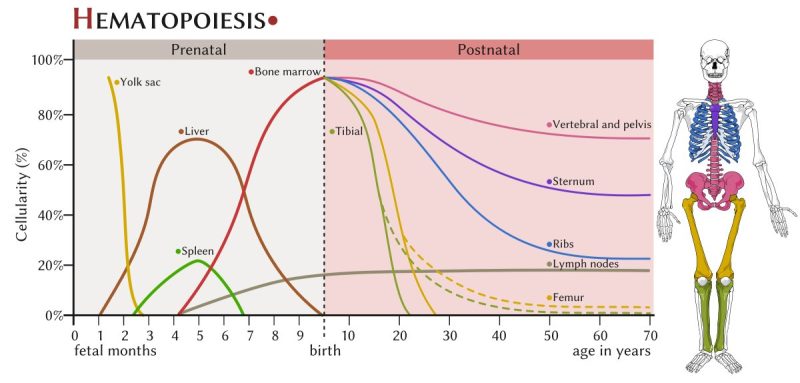David Steensma, Chief Medical Officer at Ajax Therapeutics, made the following post on Twitter:
“Did you ever wonder why our marrow is located inside of our *bones*? There’s no a priori anatomical reason it should be sited there. Blood cells could form in our spleens & livers, as they do during our fetal lives; or elsewhere, as in some animals. Let’s discuss!
After all, zebrafish get along just fine making blood cells in their “kidney marrow”, keeping Dr. Len Zon‘s lab running. Drosophila make blood-like cells in abdominal hubs, and frogs… frogs mix it up. Jeremiah Bullfrog & frog cousins make blood in kidneys, marrow, liver, etc.
Hematopoietic stem cells (HSCs) are like seafarers or long-haul truckers: they have a tough, unforgiving job requiring long hours. They must generate >2×10¹¹ blood cells daily, over the course of an organismal lifespan that might span >100 years.
HSCs are also more radiosensitive than many other types of cells, possibly because of their rate of division and lack of differentiation. This radiosensitivity, which has been shown repeatedly in accidental and intentional human exposures, is an important part of our story.
Recall that there are 4 major types of radiation: alpha, beta, gamma (eg X-rays), & neutron. Cosmic radiation (muons, etc) is another type, but weakly interacting so we can ignore it. And alpha and beta are not deeply penetrating. So gamma and neutron radiation are key here.
Animal life originated in the seas >500 million years ago (mya). The sea is different from the air: water attenuates gamma & neutron radiation very well. So sub-surface sea creatures could have HSCs pretty much anywhere in fleshy bodies without major radiation damage worries.
Early sea creatures had bigger concerns than ionizing radiation. Watch out for the giant sharp-toothed Mesozoic predator heading in your direction…
About 400 mya, some sea animals began to transition to living partly or entirely on land. There would have been several advantages to land life. Laying eggs in sand keeps them from sea predators. There were already abundant plants to eat, too.
But even though land was attractive from a nutrition & predator safety standpoint, it was dangerous in invisible ways. Around the time organisms emerged to land in the history of our planet, there was more ionizing radiation than there is now; some of it was from potassium-40.
Also, while atmospheric oxygen levels were very low in Earth’s first few billion years, they were at an all-time high (>30%) ~450 mya. Oxygen enhances DNA damage by radiation: that’s why radiation oncologists once did many trials of erythropoietin in cancer.
One body tissue does a great job of shielding from gamma/neutron radiation: bone. Bone hydroxyapatite attenuates radiation similarly to concrete – that’s the basis of radiographs. Animals whose HSCs randomly ended up inside bone would have their HSCs protected from radiation.
If the bone also adapted its interior to allow HSCs to thrive, there would have been strong positive evolutionary selection for such animals, similar to how blood doping helps Tour de France racers win. (Radiation would also have been attenuated by yellow fat inside marrow.)
So is it a coincidence that the first anatomical evidence suggestive of marrow is from 370 mya, in Eusthenopteron, a tetrapod sarcopterygian (bony fish)? These kinds of tetrapods are the ancestors of sauropsids (dinosaurs/reptiles/birds) and all extant mammals, including you.
That discovery of proto-marrow cavities in the humerus of Devonian-period Eusthenopteron tetrapods was reported in 2014 by Sophie Sanchez, Uppsala University and her colleagues, using the European Synchrotron Radiation Facility to image the fossils, read more here.
Whales, dolphins and other marine mammals are an interesting case: unlike fish, they have bone marrow. It’s an evolutionary remnant from their time on land before returning to the sea. But they likely don’t really need it; their hematopoiesis could safely move somewhere else.
My longtime friend Bob Gale & 2 radiobiology expert colleagues (James Welsh & P. Andrew Karam) recently published a paper in Leukemia Journal highlighting how “ontogeny recapitulates phylogeny”, with migration of embryonic hepatosplenic hematopoiesis to adult hematopoiesis in marrow.
I asked Bob a few weeks ago while at the MPN15 meeting in NYC – what about other tissues, such as gonads and lymph nodes, that contain many radiosensitive cells but are not bone-shielded? He felt there may be some advantages to mutagenesis in those tissues. But we don’t know.
Of course as with most evolutionary / teleology explanations, the reasons for why we have bone marrow can’t be proven, but it makes sense and is fascinating to think about. And I thank Bob – you may know him from his Chernobyl work – for calling my attention to this story.
TL;DR: blood stem cells are damaged by radiation. Seawater doesn’t allow gamma/neutron radiation to pass; air does. Unlike sea creatures, land animals would have stem cell damage without shielding. Bone’s a good radiation shield. So land animals have blood stem cells inside bone.”

Source: David Steensma/X
